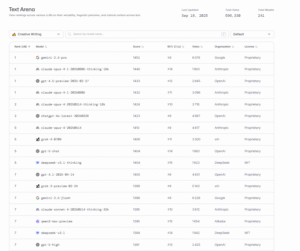When you need to do research and write scientific content, there are now plenty AI tools to make your work better.
But which one is the most reliable and effective ?
Below I’ve ranked the top AI platforms that help academic and research professionals based on personal experience & user reviews.
| Rank | AI Tool | Best for / Core Strength | From Price* | Stand-out Feature(s) |
|---|---|---|---|---|
| 1 | Paperpal | All-in-one academic writing coach | Free / $25 mo | AI Review, 10 000+ citation styles, MS Word/Overleaf plug-ins |
| 2 | ChatGPT • Gemini &bull> Perplexity (Deep Research) | Autonomous, fully-cited web reports | Free–$50 mo | Live web browsing, multimodal input, export-ready reports |
| 3 | Elicit | Evidence tables & data extraction | Free / $12 mo | 125 M-paper corpus, quote-level citations, systematic-review helpers |
| 4 | SciSpace | PDF comprehension & AI writing | Free / $20 mo | Copilot “Chat with PDF,” 200 M-paper search, Deep Review agent |
| 5 | Aithor | Fast essay drafting | €17.99 mo | Outline-to-draft flow, “undetectable” rewriting, 10 M-PDF source base |
| 6 | Jenni AI | Autocomplete-while-you-write | Free / $20 mo | Smart completions, Zotero/Mendeley citation library, 200 free words day-¹ |
| 7 | Blainy | All-round student assistant | Free / $12 mo | 200 free words day-¹, in-text “find & cite” search, PDF chat |
| 8 | ResearchRabbit | Literature discovery graphs | Free | Interactive citation networks, paper alerts, topic timelines |
*“From Price” reflects the starting monthly plan listed; check each site for current pricing and regions.
1. Paperpal
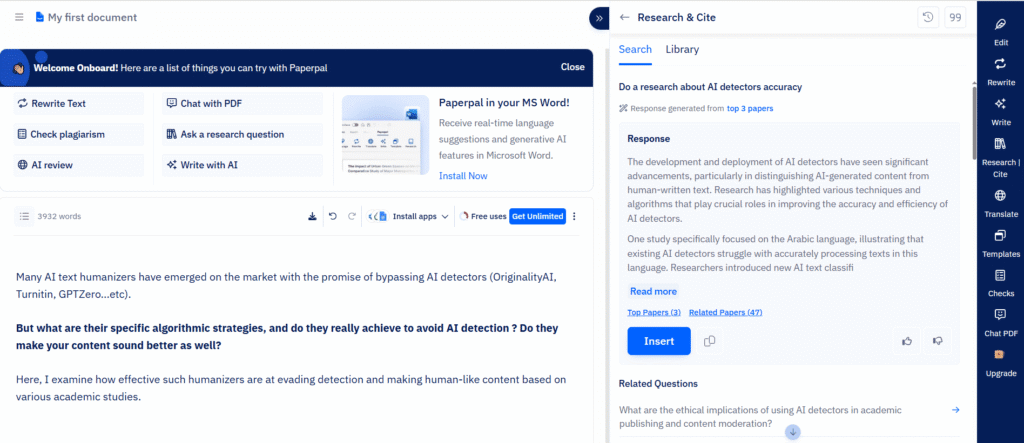
Paperpal is an all-in-one AI writing assistant tailored for academic writing and publishing. It acts like a super-charged editor and reviewer for your manuscript
Try out Paperpal for Free here
Key Features:
- Language enhancement : Paperpal will automatically correct grammar and spelling, suggest academic phrasing, and ensure your text meets formal scholarly standards (it was trained on millions of academic papers to learn the style
- Contextual suggestions that preserve technical terminology while improving clarity. Paperpal also goes beyond a typical grammar checker with features like a
- Reference Finder (you can search a database of 250+ million research articles and get science-backed answers or related paper suggestions as you write), and a built-in Citation Generator supporting 10,000+ citation styles.
- AI Review feature: Paperpal will scan your document and give instant feedback on sections that lack clarity, have technical issues, or don’t meet journal guidelines (for example, it flags inconsistent terminology, missing declarations, or excessive passive voice). It basically acts as a virtual manuscript coach to help you get a submission-ready paper.
- A paraphraser/rewriter to adjust tone or reduce wordiness, plagiarism checking, and even a “Chat with PDF” feature where you can ask questions about a PDF (similar to SciSpace’s copilot). Paperpal integrates with where researchers write: there are plug-ins for MS Word, Google Docs, Overleaf (LaTeX), and a web editor.
Underlying Model: Paperpal is developed by Cactus Communications (a company with decades of experience in academic editing). Under the hood, Paperpal uses custom AI models trained on scholarly literature and editing patterns. It likely incorporates transformer-based language models fine-tuned specifically for academic English (to correct grammar while respecting domain-specific language). The tool’s ability to find relevant papers suggests it’s connected to an index (possibly Semantic Scholar’s corpus or Crossref) and uses AI to match context. Paperpal’s models have a strong focus on preserving meaning and technical accuracy, as evidenced by its suggestions not messing up technical terms. It’s not explicitly stated which base model is used for generation, but given the emphasis on trained on millions of articles, it’s a specialized AI rather than a generic LLM model.
Pricing:
- Paperpal has a free tier that allows basic language checks (there’s often a word-count limit per upload or a cap on daily usage for free users).
- For full features, they offer Paperpal Prime subscriptions. Pricing starts around $25/month for individuals, with discounts for longer plans (e.g. roughly $139/year as per promotions). The paid plan unlocks unlimited access to all features: unlimited AI suggestions, full manuscript AI reviews, unlimited reference searches, and so on.
User Review: According to researchers who have tried it, Paperpal is excellent for polishing a paper’s language and analyzing multiple PDFs, but it’s not a “write everything for me” tool. Users also appreciate the multi-language support (it has a DeepL-powered translation to help non-native English speakers maintain an academic tone). The export options also earned praise, as Paperpal preserves formatting in Word/PDF and keeps the bibliography intact.
On the downside, some note it lacks an autocomplete writing feature for now – unlike Jenni or SciSpace Writer, Paperpal won’t continue your sentence; it focuses more on improving what you’ve written. Citation management, while robust in styles, can feel clunky in the interface (no easy way to edit a citation once inserted, etc.). For AI-generated content, a user noted Paperpal’s paraphrasing and AI writing suggestions sometimes need explicit guidance, otherwise it might not capture your intended context perfectly.
My personal experience : AI report good but not completely exhaustive, but definitely the most versatile tool for researchers (writing assistant, deep research, correction & citation features…).
2. ChatGPT, Gemini, Perplexity Deep Research
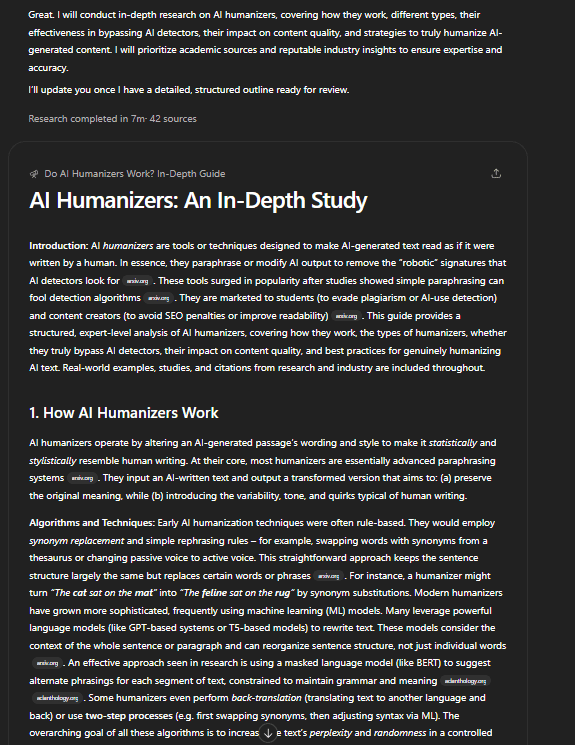
ChatGPT, Gemini, Perplexity all provide agent-style web researchers that plan searches, read sources, and hand you a fully-cited report.
Key Features :
- ChatGPT Deep Research
- Autonomous workflow: once you choose the Deep Research model, ChatGPT breaks your prompt into subtasks, issues dozens of live web queries, reads the pages, and refines its plan until it can draft a multi-page report. The whole process is transparent—you can expand a side-panel to see the chain-of-thought and every URL it opened.
- Rich inputs & outputs: you can attach PDFs, images, or spreadsheets; the agent reads them alongside its web finds, weaves data tables or charts into the final write-up, and footnotes every claim.
- Timing & scale: simple topics finish in ≈5 minutes; deep industry or policy reports may take 30 minutes, but still compress hours of human work.
- Gemini Deep Research
- Interactive plan-builder: before it starts, Gemini 2.5 Pro shows you an editable research outline; you can add or remove sub-questions, then watch a live “thoughts” stream as the agent browses hundreds of sites.
- Multimodal reasoning: besides web pages, Gemini accepts images, large codebases, and up to 1 million tokens of text—so you can drop a 1 500-page industry report in and ask it to cross-check fresh sources.
- Canvas & export: results arrive as a scrollable report plus an interactive Canvas you can reorganize, convert into mind-maps, or copy straight into Docs/Slides.
- Perplexity Deep Research
- Search-and-code loop: the agent iteratively googles, runs snippets of Python when helpful (e.g., quick stats from tables), ranks evidence, and writes a narrative answer with inline footnotes that expand to full citations.
- Fast export & sharing: when finished (usually 2-4 minutes), you can export to PDF or turn the output into a public Perplexity Page for colleagues.
- Spaces & follow-ups: store a research session in a “Space,” reopen it later, and ask follow-up questions that build on the same evidence graph—handy for living literature reviews.
Underlying Model :
- ChatGPT – Runs on OpenAI o3 (Plus/Team) or o3-pro (Pro/Enterprise). o3 is a GPT-4-class successor tuned for web navigation and long-context reasoning; o3-pro adds extra context and tool-use layers.
- Gemini – Uses Gemini 2.5 Pro (1 M token window) for Deep Research; the Mixture-of-Experts architecture lets the agent call specialist “experts” for reasoning, planning, and multimodal analysis.
- Perplexity – Orchestrates external LLMs (GPT-4o, Claude 3.7, Gemini Flash) behind its own retrieval-and-reasoning stack; this hybrid scored 21.1 % on the tough Humanity’s Last Exam benchmark.
Pricing & Usage Limits :
| Plan | ChatGPT Deep Research | Gemini Deep Research | Perplexity Deep Research |
|---|---|---|---|
| Free tier | Not available | Free preview (daily cap) | 5 runs / day |
| Entry | Plus $20/mo → 10 runs / mo | Google One AI Premium $19.99/mo → unlimited personal use | Pro $20/mo → 300 runs / day |
| Power | Pro $200/mo → 120 runs / mo, longer contexts | — | Max $50/mo → unlimited runs, API credits |
Performance & User Reviews :
- ChatGPT Deep Research
- Tech journalists found the reports “worth the 30-minute wait,” praising the clarity of citations but noting occasional reliance on Wikipedia or weaker sources that need human vetting.
- Benchmark lead: 26.6 % on Humanity’s Last Exam—currently the highest published score for autonomous research agents.
- Gemini Deep Research
- TechRadar applauds Gemini’s free access and real-time thought stream, calling it “great for casual queries,” but testers say it can “over-think” niche engineering problems and still lags ChatGPT on numerical accuracy.
- Strengths lie in multimodal prompts (pictures of lab setups, raw CSVs) and the giant context window, which reviewers say “lets you paste an entire dissertation and ask follow-ups in seconds.”
- Perplexity Deep Research
- Researchers love the speed and footnoted answers—Tom’s Guide’s month-long test concluded it’s “a compelling Google replacement for learning-heavy tasks.”
- Community feedback on Reddit highlights its transparency but notes newer updates sometimes run slower or over-include marginal sources; still, most users find accuracy solid for literature sweeps.
- On benchmarks, Perplexity’s 21.1 % HLE score beats Gemini Thinking and open-source rivals, though it trails ChatGPT’s agent.
My personal experience : I got the most comprehensive & accurate AI reports with DeepResearch especially with ChatGPT’s version of the feature.
3. Elicit
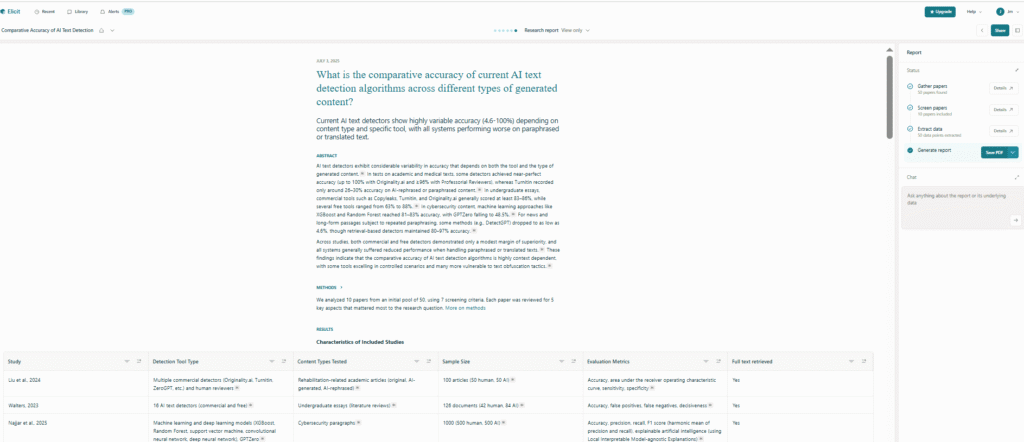
Elicit is an AI research assistant focused on literature review and evidence synthesis. Unlike general chatbots, Elicit is designed to find relevant academic papers and summarize their findings for you.
Key Features:
- Research chatbot : you pose a research question (e.g. “What are the effects of X on Y according to recent studies?”), and Elicit will search a corpus of 125+ million academic publications for answers. It then presents a list of relevant papers in a table, showing each paper’s title, a summary of its answer or findings, and even specific data extracted (like sample size or results if you request that).
- Evidence extraction: you can upload your own set of PDFs or provide a topic, and Elicit can pull out specific data points or outcomes from the methods/results of those papers (a huge help for systematic reviews).
- Feature to compare papers side by side on key metrics. All of Elicit’s answers are accompanied by direct quote citations from the source papers (so you can verify each claim).
- PDF uploads, allowing you to Q&A your own documents (somewhat like SciSpace’s PDF chat).
Underlying Model: Elicit is developed by the nonprofit Ought and was one of the earliest AI tools explicitly for researchers. It uses a combination of GPT-based language models for understanding questions and summarizing text, and a massive academic database via Semantic Scholar for retrieval. Specifically, Elicit’s backend searches the Semantic Scholar Open Research Corpus (which spans virtually all fields) and possibly other sources. The language model likely a reasoning one is fine-tuned for tasks like summarization of academic texts, extracting numeric results, and comparing findings.
Pricing:
- Elicit free tier. All its major features – searching for papers, summary tables, PDF Q&A, etc. – are available without a subscription. There are some limits (for instance, when extracting data from papers, free users can process a certain number of papers per month: Basic tier allows 20 PDF extractions per month, etc.).
- Plus at $12/month and Pro at $49/month, which expand those limits dramatically (e.g. Pro lets you extract data from up to 200 papers a month, and even offers features for systematic review workflows).
User Review: Users report that Elicit is great for discovering papers they would have otherwise missed via keyword searches – the AI can interpret your question and find relevant studies including those that use different terminology. The summaries it provides (the TL;DR of each paper) are generally spot-on and save a lot of reading time. A big plus is that Elicit doesn’t fabricate citations – everything it shows is directly from actual papers, which builds trust. One PhD student noted, “It’s like Google Scholar meets ChatGPT, but with verification”. Another common use is to quickly populate a table of evidence: say you’re writing about a medical intervention, Elicit can list the top studies, their sample sizes, outcomes, and limitations in a neat table that you can then reference.
Of course, users caution that Elicit’s AI isn’t perfect. Sometimes it might miss a highly relevant paper if that paper’s abstract is phrased oddly (AI still has to understand it). And the quality of its answers depends on what’s in the literature; if the literature is sparse or inconclusive, Elicit will reflect that. But even that is useful (it shows where more research is needed). New users should also be aware that Elicit’s interface is a bit more utilitarian – it’s not a fancy chat interface, but rather a research dashboard.
My personal experience : less features than Paperpal, but the best AI reports & research excluding DeepResearch features from LLM providers.
4. SciSpace (Previously Typeset.io)
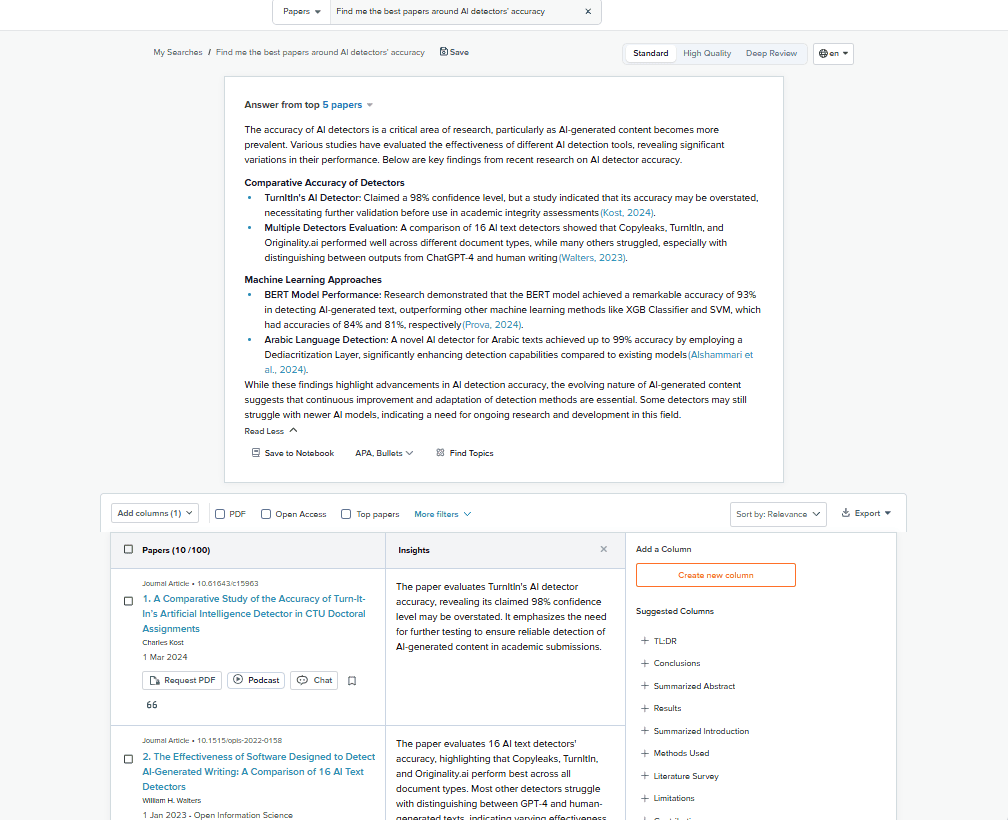
SciSpace is an AI-powered platform aimed at accelerating literature reviews and understanding research papers. It has a suite of features that cover searching for papers, comprehending them, and even writing with citations.
Key Features:
- SciSpace Copilot (Chat with PDF): you upload a research paper PDF, and you can then ask the AI questions about the paper. It will give you answers that are precisely sourced from the document, often quoting the exact part of the text with a citation.
- Literature Review AI assistant: you can query a topic or research question, and it will search a database of over 200 million papers to find relevant publications and present answers in a structured table format. The answers highlight which sources support which findings, and you can filter results by criteria like publication venue or PDF availability.
- “Deep Review,” an AI agent that attempts to conduct systematic literature reviews for you – it can refine search terms, read through multiple paper abstracts, and summarize findings (this is a premium offering geared for comprehensive reviews).
- AI Writer module: similar to Jenni, it can autocomplete text and suggest sentences as you write, with relevant citation suggestions that update your reference list in real time.
- There’s also 20+ tone Paraphraser, AI translator (75+ languages), and even an AI-powered “PDF to video” converter that produces a video summary of a paper
Underlying Model: SciSpace leverages multiple AI models and techniques. For the Chat with PDF, it uses a retrieval augmented model – likely GPT-4o or a comparable LLM – which is fed the text of your PDF (split into chunks) and is instructed to only answer from that text. This ensures accuracy and grounding in the source. The literature search feature indicates SciSpace has an index of 200+ million papers (probably via partnerships or databases like Semantic Scholar). For that, it might use vector embeddings to match your query with relevant papers and then use an LLM to summarize or extract answers from their abstracts/intros.
Pricing:
- Free tier with quite a lot: you can chat with a limited number of PDFs, perform literature searches with some daily limit, and use the paraphraser and AI writer in a limited capacity.
- SciSpace Premium is about $20/month (or $240/year). Premium gives unlimited chats with PDFs, unlimited literature searches, and unlimited use of the AI writer and other tools.
- Deep Review add-on (targeted at institutions or very intensive reviewers) has a higher price – around $70/month – but that’s for a specialized use-case of fully automated systematic reviews.
User Review: Many PhD students say SciSpace significantly speeds up reading papers – you can ask the Copilot “What are the main findings of this study?” or “Explain Figure 2” and get an instant, clear summary with no need to wade through jargon. This is a huge time-saver, and the accuracy is generally high because the answers are pulled straight from the text with citations. Users also like the literature review tool for giving a quick map of the field.
However, power users warn that the tool is only as effective as how you use it. If you rely blindly on it, you might miss nuances – for instance, SciSpace might highlight certain papers but you still need to critically read key ones. Privacy and customer support have been a concern in the past: there were complaints about papers uploaded being made public via the PDF-to-video feature (SciSpace responded by adjusting privacy settings).
My personal experience : variety of features, and good AI reports.
5. Aithor
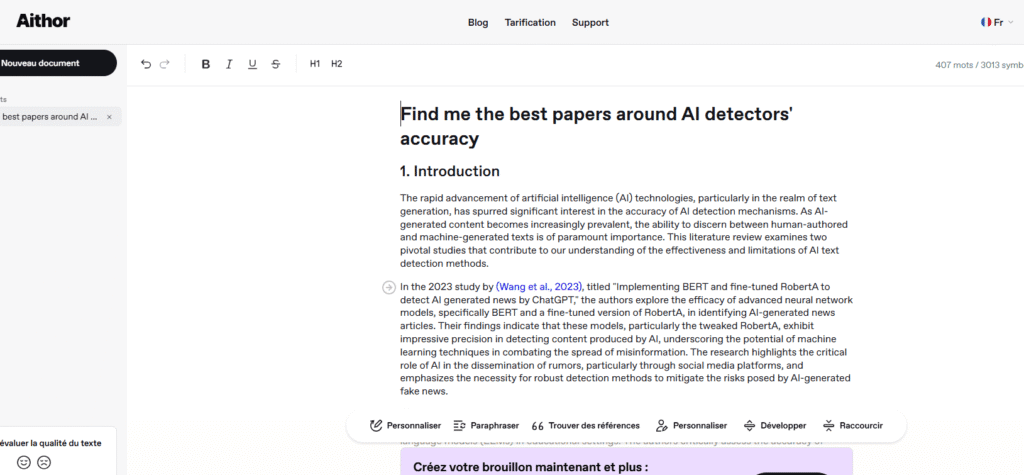
Aithor is an AI writing assistant positioned as “your undetectable AI writer” with a strong focus on academic essays and papers. It combines content generation with research capabilities.
Key Features:
- Automated outline creator: you provide your essay topic or thesis, and Aithor will generate a structured outline with sections and points. This helps ensure your piece has logical flow from the start.
- AI Draft Writer can expand that outline into a full draft, producing content for each section at your request.
- “In-text citations” feature – after generating content, it offers a list of sources (actual books, papers, or articles) that were relevant to the content it wrote. You can pick which sources to include, and it will insert citations for you.
- Aithor has access to over 10 million full-text PDFs in its knowledge base, meaning it tries to draw information from actual publications (thus reducing hallucination and increasing factuality for research topics).
- “Humanize” or “Disguise” tool: Aithor will rephrase AI-generated content to be more human-like and “undetectable” by AI detectors. This addresses the concern some have about AI-written text being flagged.
Underlying Model: Aithor appears to use OpenAI’s GPT-4o or Gemini 2,5 behind the scenes – in its interface, it references GPT-4 and Gemini as technologies available. It likely routes user queries through these powerful LLMs and then applies its own layers for specific tasks like outline generation or citation matching. Additionally, Aithor’s integration of a 10M+ PDF database suggests it uses a retrieval system: when you request content with citations, it probably does a keyword search in its academic database, then feeds relevant excerpts to the LLM to incorporate into the draft.
Pricing:
- Free trial (they mention 10,000 free tokens for new users to explore), but it primarily runs on a subscription model.
- €17.99/month for a monthly plan, with discounts for longer commitments (e.g. ~€12/month if paid quarterly, and about €7/month if paid annually).All paid plans include the same features; the longer plans just save money. Features unlocked include unlimited use of LLM, unlimited essay downloads/exports, all the writing tools, and multi-platform access. Notably, Aithor supports WhatsApp/Telegram bots and mobile apps for subscribers, so you can use it on the go. They also highlight that premium gives you things like image analysis, PDF upload and analysis, and organizing chats in folders.
User Review: Students and academic users of Aithor often comment on its ease of use and time saved. On Trustpilot, Aithor holds about a 4.1/5 rating with users calling it a “game-changer” for speeding up writing while maintaining quality. They appreciate how clear and concise the AI’s outputs are, and that the sources provided are accurate. Many reviews highlight that it helped them structure their essays better and tailor content to assignment requirements. The ability to ask Aithor questions at any time (like a 24/7 tutor) gets positive mentions.
On the flip side, some independent reviews note that Aithor’s content generation can be a bit generic if used naively – one reviewer found that without careful prompts, the essays felt formulaic and the tone adjustments were limited. The free usage is also very limited (only a short snippet before paywall), which frustrated a few who wanted to test it more before subscribing Additionally, while Aithor claims “undetectable” text, users are reminded to still review and edit the output to match their personal voice (to avoid any academic integrity issues).
My personal experience : good essay writer, but research features less comprehensive.
6. Jenni AI
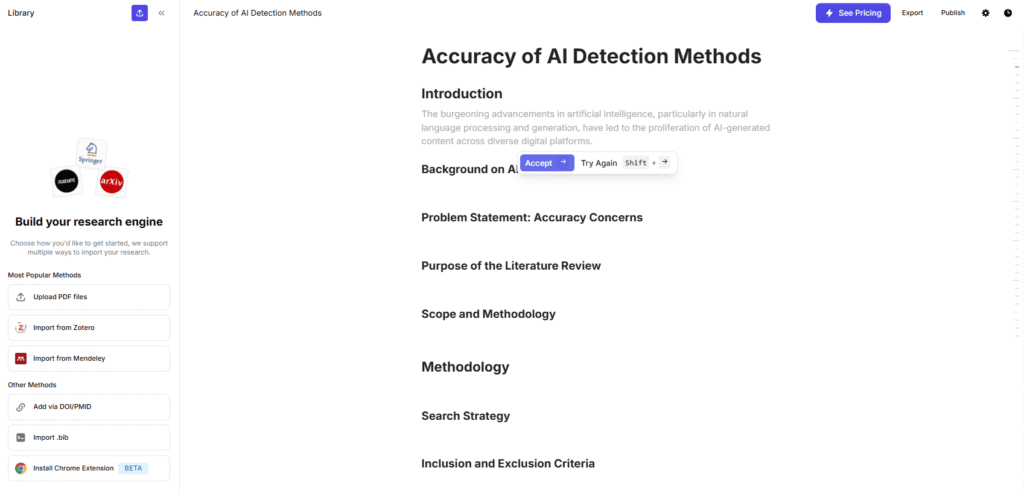
Jenni AI is a popular AI writing assistant that works with you as you write. It’s designed to help generate content for essays, papers, or articles in a way that keeps you in control.
Key Features:
- AI Autocomplete: as you write sentences, Jenni can suggest how to continue them, almost like Gmail’s smart compose but for long-form academic writing. This helps overcome writer’s block and speeds up drafting.
- Citation support – it can find relevant references to back up a statement and insert the citation for you (with over 1,700 citation styles supported). You can actually save papers to a personal library in Jenni, and then cite them on the fly. It integrates with Zotero and Mendeley to import all your saved references in seconds, so all your sources are at your fingertips while writing.
- AI paraphrasing and rewriter tool, allowing you to select text and have it rephrased in a different tone or to improve clarity.
- Outline generator: give Jenni a prompt or topic, and it will suggest a structured outline (sections and headings) for your paper, which you can then flesh out.
Underlying Model: Jenni doesn’t disclose its exact model, but it likely uses one advanced LLM model like OpenAI’s GPT-4o or Claude 4 via API with some fine-tuning for academic contexts. The developers have clearly optimized Jenni for scholarly writing: its suggestions often come out in a formal, evidence-backed style (and when it cites, it’s pulling from real papers). The underlying AI model is thus a large language model capable of high-quality text generation.
Pricing:
- Jenni AI uses a freemium model. Everyone gets 200 free AI-generated words per day (which reset daily) to test it out. This is enough to see how the autocomplete and citing work on a small paragraph.
- For unlimited usage, Jenni has a single Unlimited plan at $20/month (or $12/month if paid annually, which is 40% off). The Unlimited plan gives you unlimited AI words, unlimited citations, unlimited PDF uploads for analysis, and full document exports. Students often qualify for discounts (Jenni has run student promos, so look out for those).
- Also, there is a team/institution plan available for universities which provides multiple seats and admin tools.
User Review: Jenni has a strong fanbase among student writers and researchers. Users often mention that Jenni feels like writing with a knowledgeable friend – it doesn’t take over the process, but its suggestions and auto-completions keep you moving forward. Many appreciate the UI’s ease of use and how seamlessly the citation insertion works. For example, if you write “According to [Author] (2020)…”, Jenni might suggest the rest of the sentence and add the citation from your library.
On the flip side, because Jenni relies on user input and prompting, it’s not a fully autonomous writer – you do need to guide it with partial sentences or prompts. A few users say that for very technical or novel content, Jenni might need careful prompting to avoid generic outputs. However, the general sentiment is that Jenni significantly improves the writing workflow, especially for generating first drafts and ensuring proper citations.
My personal experience : good for outlining and researching but less so other research tasks.
7. Blainy
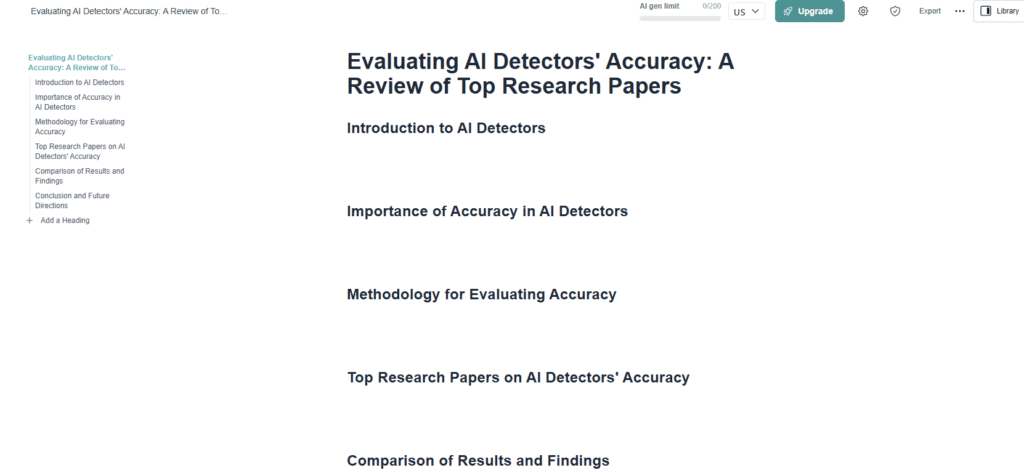
Blainy is an AI-powered academic writing assistant that markets itself as “the world’s #1 research paper writer.” It provides a dashboard of tools specifically to help students and researchers craft well-structured, well-sourced papers quickly
Key Features:
- AI Autocomplete for writing (predicts and completes your sentences or paragraphs intelligently)
- “Chat to your PDFs” function (allowing you to converse with your research PDFs to extract information, much like SciSpace’s copilot)
- Paraphrase & Rewrite tool to reword content while keeping the meaning.
- Search millions of papers on the fly and cite them easily. As you write, you can query its database for supporting literature and it will insert in-text citations in the style you need (APA, MLA, IEEE, Harvard, etc.).
- Structured outlining and a research library where you can store and organize references.
- Write with AI” mode to generate content for each section of a paper, or use its AI Q&A to clarify concepts while writing.
Underlying Model: Blainy leverages advanced large language models and combines them with its own academic content index. Blainy’s backend has a research paper database (they advertise millions of papers) which suggests a retrieval component for citations. When you ask Blainy to cite something, it probably performs a semantic search in its database, finds a relevant paper, and then uses the LLM to integrate that info into your text. The focus on “undetectable AI” implies they might also do some post-generation tweaking to avoid easily flagged patterns (much like Aithor).
Pricing:
- Robust Free plan. The Free plan (no credit card needed) gives you 200 AI-generated words per day, basic paraphrasing, instant search and citation insertion, and limited autocomplete suggestions. This free tier is great for short essays or trying out the tool.
- Unlimited plan at $12/month (annual) or $20/month (monthly). The Unlimited plan provides unlimited AI words, full access to advanced paraphrasing and autocomplete, multiple citation styles, full outlining features, and priority support. Essentially, the paid plan removes the daily cap and unlocks all features without restrictions.
User Review: As a relatively new entrant, Blainy has been getting positive buzz among students. Users say Blainy’s interface is clean and intuitive, making the writing process less intimidating. The immediate impact is speed – some report finishing assignments much faster because Blainy handles the mundane parts (formatting citations, suggesting the next sentence) so they can focus on ideas. The in-text citation feature gets a lot of praise; students love that they can highlight a claim and ask Blainy for a source, and it’ll drop one in with proper formatting. It reduces the need to manually search Google Scholar.
Anecdotally, early adopters compare it favorably to better-known tools: for example, someone said the autocomplete felt as good as Jenni’s, and the PDF chat as good as SciSpace’s, all within one app. Criticisms include minor bugs (as it’s newer, a few glitches in the web app were reported, like occasional lag in loading the library). And while the free 200 words/day is great, some note that serious writing will hit that limit quickly – essentially nudging users to subscribe (which is understandable, but something to be aware of so you’re not surprised mid-essay).
My personal experience : a poorer version of Jenni editor but still a lot of tools.
8. ResearchRabbit
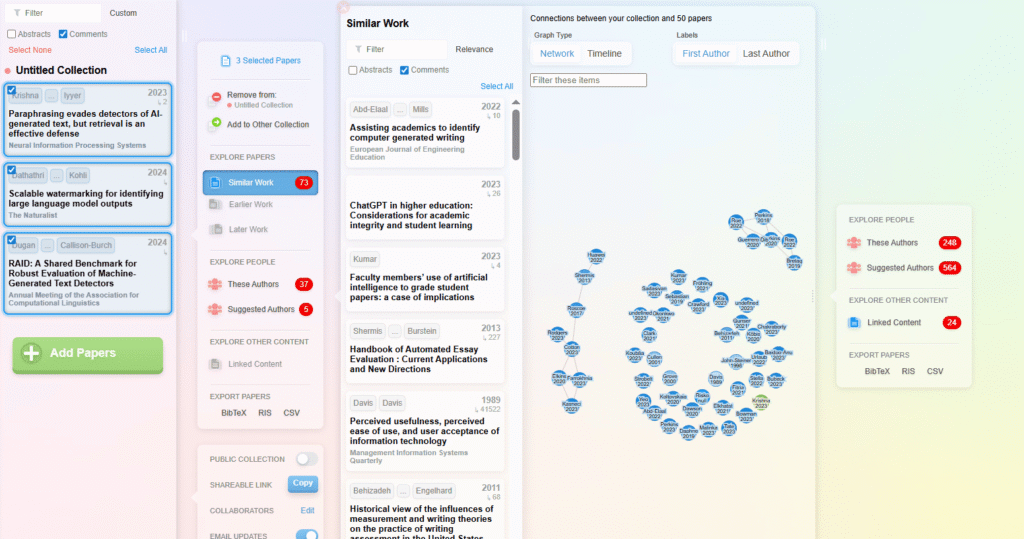
ResearchRabbit is a different breed of tool on this list – rather than generating text, it’s an AI-powered literature discovery and mapping tool. It’s incredibly useful for the research phase of scientific writing.
Key Features:
- Visual paper mapping: you input a few papers or an author important to your topic, and ResearchRabbit will generate a network graph of papers showing how they are connected (through citations, co-authorships, or topic similarity).
- Recommendation engine: as you add papers to a collection, it suggests other papers that you might not have known about but are highly relevant (kind of like a Spotify Discover Weekly but for research papers).
- Alerts and monitoring – you can “follow” a collection or an author, and it will notify you of new papers or preprints that match your interests, ensuring you stay up-to-date.
- Search functionality as well, which uses a combination of keyword and AI similarity search to find papers (often retrieving some that traditional keyword searches miss). While ResearchRabbit doesn’t write content, it hugely supports scientific writing by helping writers assemble a comprehensive bibliography and ensure no major work is overlooked.
- Timeline feature: it can show you the evolution of a research topic over time by ordering key papers chronologically.
Underlying Model: ResearchRabbit employs machine learning models to analyze paper metadata, citation networks, and content similarity. It likely uses embedding models for documents to gauge which papers are related beyond direct citations. By creating a graph of how papers cite each other, it leverages network algorithms to find clusters of related work. There is AI involved in the recommendation system: it learns from which papers you save or like to refine its suggestions (using a model that probably combines citation-based similarity with content-based similarity – possibly using NLP on titles/abstracts).
Pricing:
- ResearchRabbit launched as a free tool and hasn’t put up paywalls for its core features. You can sign up on their website and start building collections and graphs with no cost.
- They may introduce premium features in the future, but the developers have expressed commitment to keeping it accessible to researchers.
User Review: Researchers absolutely love ResearchRabbit for exploring literature efficiently. Many have described it as a “game changer for literature reviews.” Users enjoy the visual graphs – it turns what used to be weeks of search and citation-chasing into an interactive experience where you can literally see which papers are hubs of information. The ability to follow an author’s work through their network graph is also praised, as it uncovers collaborations and related work from that author’s circle.
On the flip side, because it doesn’t generate summaries, some combine it with other tools (for instance, use ResearchRabbit to get the papers, then use Elicit or SciSpace to quickly summarize those papers). Another piece of feedback: it can be a bit overwhelming at first – the graph can explode with many nodes if you don’t apply filters, so new users might need to learn how to focus (there are features to limit by year, or by relevance). Also, while it covers a vast range of papers, extremely recent or niche papers might not appear until their databases update.
My personal experience : really good for storing and researching new papers in one place but no true “AI” feature.





